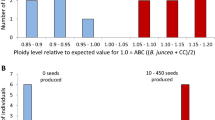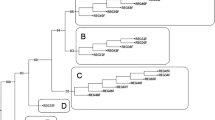Abstract
Brassica is a key agricultural genus, containing oilseed and vegetable crops sharing three major genomes (A, B and C) distributed in diploid (genome: AA, BB and CC) and allotetraploid (genome: AABB, AACC and BBCC) species. Interspecific hybridisation between Brassica species is an important way to combine valuable characters of different species. In the present study, interspecific hybrids between tuber mustard (AABB) and red cabbage (CC) were obtained with the aid of embryo culture. The results showed that ovules at five different maturity levels (7, 9, 10, 13 and 14 days after pollination), which were cultured on Murashige and Skoog medium supplemented with 3 % sucrose, 0.2 % active carbon and 400 mg/L glutamine, showed varying seed survival rates. A total of 15 (5 %) seeds were obtained, with ovules cultured at 14 days after pollination yielding the most seeds. Subsequently, eight (53 %) of the seeds did not germinate into normal plants. Furthermore, the putative hybrids were confirmed by random amplified polymorphic DNA (RAPD) and flow cytometry analysis, and only one (14 %) of the seven plants was confirmed to be a true tri-genomic hybrid (genome: ABC). Then the nodal segments of the true hybrid were treated with liquid medium supplemented with colchicine to obtain an allohexaploid, as confirmed by flow cytometry analysis and morphological observation. The synthesized hybrid showed unique phenotypes in comparison with the parents, such as in stem colour and leaf margin. The synthesized Brassica tri-genomic vegetable germplasm with A, B and C genomes has potential as a source of new crops for agriculture as well as a basis for further investigation of the mechanisms of Brassica evolution and adaptation.






Similar content being viewed by others
References
Allard RW, Garcia P, Saenz-de-Miera LE, Delavega MP (1993) Evolution of Multilocus Genetic Structure in Avena hirtula and Avena barbata. Genetics 135:1125–1139
Arumugam N, Mukhopadhyay A, Gupta V, Pental D, Pradhan AK (1996) Synthesis of hexaploid (AABBCC) somatic hybrids: a bridging material for transfer of “tour” cytoplasmic male sterility to different Brassica species. Theor Appl Genet 92:762–768
Attia T, Busso C, Robbelen G (1987) Digenomic triploids for assessment of chromosome relationships in the cultivated diploid Brassica species. Genome 29:326–330
Ayotte R, Harney PM, Machado VS (1988) The transfer of triazine resistance from Brassica napus L. to B. oleracea L.II. Morphology, fertility and cytology of F1 hybrid. Euphytica 37:189–197
Bing DJ, Downey RK, Rakow GFW (1996) Hybridizations among Brassica napus, B. rapa and B. juncea and their two weedy relatives B. nigra and Sinapis arvensis under open pollination conditions in the field. Plant Breed 115:470–473
Chen LP, Zhang MF, Li CS, Hirata Y (2005) Production of interspecific somatic hybrids between tuber mustard (Brassica juncea) and red cabbage (Brassica oleracea). Plant Cell Tissue Organ Cult 80:305–311
Chen S, Nelson MN, Chèvre AM, Jenczewski E, Li ZY, Mason AS, Meng JL, Plummer JA, Pradhan A, Siddique KHM, Snowdon RJ, Yan GJ, Zhou WJ, Cowling WA (2011) Trigenomic Bridges for Brassica Improvement. Crit Rev Plant Sci 30(6):524–547
Choudhary BR, Joshi P (2001) Crossability of Brassica tournefortii and B. rapa, and morphology and cytology of their F1 hybrids. Theor Appl Genet 102:1123–1128
Combes MC, Dereeper A, Severac D, Bertrand B, Lashermes P (2013) Contribution of subgenomes to the transcriptome and their intertwined regulation in the allopolyploid Coffea arabica grown at contrasted temperatures. New Phytol 200:251–260
Deng YM, Chen SM, Lu AM, Chen FD, Tang FP, Guan ZY, Teng NJ (2010) Production and characterisation of the intergeneric hybrids between Dendranthema morifolium and Artemisia vulgaris exhibiting enhanced resistance to chrysanthemum aphid (Macrosiphoniella sanbourni). Planta 231:693–703
Diederichsen E, Sacristan MD (1994) The use of ovule culture in reciprocal hybridization between B. campestris L. and B. oleracea L. Plant Breed 113:79–82
Hoshino T, Ito S, Hatta K, Nakamura T, Yamamori M (1996) Development of waxy common wheat by haploid breeding. Breed Sci 46:185–188
Jiang Y, Tian E, Li R, Chen L, Meng J (2007) Genetic diversity of Brassica carinata with emphasis on the inter-specific crossability with B. rapa. Plant Breed 126:487–491
Leitch AR, Leitch IJ (2008) Genomic plasticity and the diversity of polyploid plants. Science 320:481–483
Lelivelt CLC (1993) Studies of pollen gain germination, pollen tube growth, micropylar penetration and seed set in intraspecific and intergeneric crosses within three Cruciferae species. Euphytica 67:185–197
Li XY, Cai YS (1992) Identification of the viruses on Sichuan Zha-Cai (Brassica juncea var. Tumida) and investigation on their occurrence at different seasons and regions. Acta Phytopathol Sin 22(3):275–276
Li XY, Yu JL (1988) A preliminary identification of resistance in Brassica juncea varieties to the Turnip mosaic virus (TuMV). Acta Phytopathol Sin 18(1):6–7
Li MT, Li ZY, Zhang CY, Qian W, Meng JL (2005) Reproduction and cytogenetic characterization of inter-specific hybrids derived from crosses between B. carinata and B. rapa. Theor Appl Genet 110:1284–1289
Liu PY (1996) Chinese mustard. In: Liu PY (ed) Origin, Evolution, Classification and Distribution of Chinese Mustard. China Agriculture Press, Beijing, pp 1–26
Mason A (2010) Meiotic behaviour and chromosome inheritance in interspecific hybrids of allotetraploid Brassica species. PhD thesis, The University of Western Australia, Perth, Australia
McGrath JM, Quiros CF (1990) Generation of alien chromosome addition lines from synthetic Brassica napus: morphology, cytology, fertility, and chromosome transmission. Genome 33:374–383
Meng J, Shi S, Gan L, Li Z, Qu X (1998) The production of yellow seeded Brassica napus (AACC) through crossing inter-specific hybrids of B. campestris (AA) and B. carinata (BBCC), with B. napus. Euphytica 103:329–333
Moeller L, Wang K (2008) Engineering with precision: tools for the new generation of transgenic crops. Bioscience 58:391–401
Nishiyama I, Sarashima M, Matsuzawa Y (1991) Critical discussion of abortive inter-specific crosses in Brassica. Plant Breed 107:288–302
Porter PM, LeGare DG (2006) Canola. Varietal trial results. Minnesota Agricultural Experiment Station, Falcon Heights
Pradhan A, Plummer JA, Nelson MN, Cowling WA, Yan G (2010a) Trigenomic hybrids from interspecific crosses between Brassica napus and B. nigra. Crop Pasture Sci 61:464–474
Pradhan A, Plummer JA, Nelson MN, Cowling WA, Yan G (2010b) Successful induction of trigenomic hexaploid Brassica from a triploid hybrid of B. napus L. and B. nigra (L.) Koch. Euphytica 176:87–98
Ramsey J, Schemske DW (1998) Pathways, mechanisms, and rates of polyploid formation in flowering plants. Annu Rev Ecol Syst 29:467–501
Schelfhout CJ, Snowdon WA, Cowling WA, Wroth JM (2006) Tracing B-genome chromatin in Brassica napus x B. juncea inter-specific progeny. Genome 49:1490–1497
Stebbins GL (1966) Chromosome variation and evolution. Science 152:1463–1469
Takeda T (1983) Studies on the synthesized hexaploid plants in genus Brassica: its stability and significance in plant breeding. Annu Rep Fac Educ Iwate Univ 42:75–217
Takeda T, Takahata Y (1996) Production of alloplasmic Chinese cabbage using synthesized trigenomic hexaploid (AABBCC) in Brassica. Acta Hortic 407:151–154
Tian E, Jiang Y, Chen L, Zhou J, Liu F, Meng J (2010) Synthesis of a Brassica trigenomic allohexaploid (B. carinata × B. rapa) de novo and its stability in subsequent generations. Theor Appl Genet 121:1431–1440
Nagaharu U (1935) Genomic analysis in Brassica with special reference to the experimental formation of B. napus and peculiar mode of fertilization. Jpn J Bot 7:389–452
Wang Y, Cheng Q, Zhu XY, Chen LP (2011) Studies on reproductive characteristics of an interspecific chimera between Brassica juncea and Brassica oleracea. Plant Cell Tissue Organ Cult 104:209–215
Weerkoon SR (2011) Producing inter-specific hybrids between Brassica juncea (L.) Czern & Coss and B.oleracea (L.) to synthesize trigenomic (ABC) Brassica. J Sci Univ Kelaniya 6:13–34
Yamagishi H, Hirai M, Yoshikawa H, Yui S (1989) Production of somatic hybrids between Black mustard (Brassica nigra KOCH; BB) and Hakuran (B. napus L.; AACC). Jpn J Plant Breed 39:229–233
Yan G, Nelson M, Pradhan A, Mason A, Weerakoon S, Si P, Plummer J, Cowling W (2009) Progress towards the creation of trigenomic Brassica hexaploid populations. SABRAO J Breed Genet 41: Published in CD (ISSN 1029–7073)
Zhang S, Hunter DJ, Forman MR, Rosner BA, Speizer FE, Colditz GA, Manson JE (1999) Dietary carotenoids and vitamins A, C, and E and risk of breast cancer. J Natl Cancer Inst 91:547–556
Zhang GQ, Zhou WJ, Gu HH, Song WJ, Momoh EJJ (2003) Plant regeneration from the hybridization of Brassica juncea and B. napus through embryo culture. J Agron Crop Sci 189:347–350
Acknowledgments
This work was supported by the National Natural Science Foundation of China (Grant no. 31401862) and the Key Science and Technology Innovation team of the Zhejiang province (Grant no. 2013TD05).
Conflict of interest
The authors declare that they have no conflict of interest.
Author information
Authors and Affiliations
Corresponding author
Electronic supplementary material
Below is the link to the electronic supplementary material.
Rights and permissions
About this article
Cite this article
Li, J., Rao, L., Meng, Q. et al. Production of Brassica tri-genomic vegetable germplasm by hybridisation between tuber mustard (Brassica juncea) and red cabbage (B. oleracea). Euphytica 204, 323–333 (2015). https://doi.org/10.1007/s10681-014-1336-5
Received:
Accepted:
Published:
Issue Date:
DOI: https://doi.org/10.1007/s10681-014-1336-5




